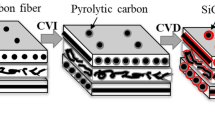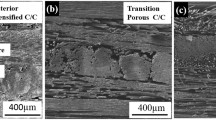Abstract
The ablation properties of C/C composites with four different needled preforms prepared by isothermal chemical vapor infiltration (ICVI), which are super-thin mat lay-up, 0°/90° weftless fabric lay-up, 0°/45° weftless fabric lay-up and 0°/45° twill fabric lay-up, were quantitatively evaluated by performing the ablation tests with an engine torch. And their ablation discrepancies were analyzed according to the surface characteristic, porosity and thermal diffusivity. The results show that the 0°/45° weftless composite has a flat eroded surface with no obvious macroscopic pits. Its thickness and mass erosion rates are decreased by about 46.8% and 34.8%, 25.0% and 27.5%, and 17.5% and 19.4% compared with those of the mat, the 0°/90° weftless and the 0°/45° twill composites, respectively. The ablation properties are mainly controlled by the thermo-chemical effect (oxidation), and a little by the thermo-mechanical effect (mechanical denudation). The needling fiber bundles play an important role in accelerating the ablation process and resulting in the heterogeneous ablation.
Similar content being viewed by others
References
SAVAGE G. Carbon-Carbon Composites[M]. London: Chapman & Hall, 1993: 137–139.
FITZER E. The future of carbon-carbon composites[J]. Carbon, 1987, 25(2): 163–190.
BUCKLEY J D. Carbon-carbon: an overview[J]. American Ceramic Society Bulletin, 1988, 67(2): 364–368.
LEE Y J, JOO H J. Ablation characteristics of carbon fiber reinforced carbon (CFRC) composites in the presence of silicon carbide (SiC) coating[J]. Surface and Coatings Technology, 2004, 180/181: 286–289.
PARK J K, CHO D, KANG T J. A comparison of the interfacial, thermal, and ablative properties between spun and filament yarn type carbon fabric/phenolic composites[J]. Carbon, 2004, 42(4): 795–804.
CHO D, LEE J Y, YOON B I. Microscopic observations of the ablation behaviors of carbon-fiber phenolic composites[J]. Journal of Material Science Letter, 1993, 12(24): 1894–1896.
CHO D, YOON B I. Microstructural interpretation of the effect of various matrices on the ablation properties of carbon-fiber-reinforced composites[J]. Composite Science and Technology, 2001, 61(2): 271–280.
YIN Jian, ZHANG Hong-bo, XIONG Xiang, et al. Microstructure and ablation performance of resin-based C/C composites[J]. Journal of Central South University: Science and Technology, 2005, 36(1): 1–5.(in Chinese)
LEE Y J, JOO H J. Investigation on ablation behavior of CFRC composites prepared at different pressures[J]. Composite: Part A, 2004, 35(11): 1285–1290.
RAN H X, CUI H, HAO Z B. Influence of carbon-matrix structure on ablative performances of C/C composites[J]. Carbon, 2002, 40(1): 20–25.
BOURRAT X, FILLION A, NASLAIN R, et al. Regenerative laminar pyrocarbon[J]. Carbon, 2002, 40(15): 2931–2945.
LUO R Y, LIU T, LI J S, et al. Thermophysical properties of carbon/carbon composites and physical mechanism of thermal expansion and thermal conductivity[J]. Carbon, 2004, 42(14): 2887–2895.
HAN J C, HE X D, DU S Y. Oxidation and ablation of 3D carbon-carbon composite up to 3 000 °C[J]. Carbon, 1995, 33(4): 473–478.
Author information
Authors and Affiliations
Corresponding author
Additional information
Foundation item: Project(200202AA305207) supported by the National High Technology Research and Development Program of China
Rights and permissions
About this article
Cite this article
Tang, Sf., Wang, Dl., Deng, Jy. et al. Ablation properties of C/C composites with various needled preforms prepared by isothermal chemical vapor infiltration. J Cent. South Univ. Technol. 14, 13–18 (2007). https://doi.org/10.1007/s11771-007-0003-6
Received:
Accepted:
Issue Date:
DOI: https://doi.org/10.1007/s11771-007-0003-6




